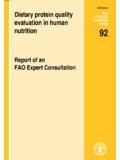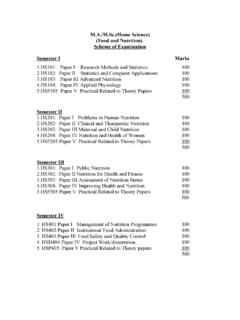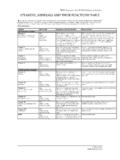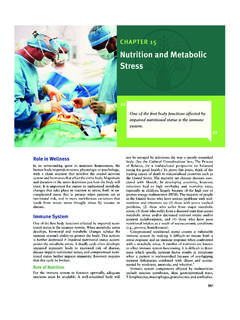Transcription of The Composition of Hemp Seed Oil and Its Potential as an ...
1 The Composition of Hemp Seed Oiland Its Potential as an Important Sourceof NutritionCary LeizerDavid RibnickyAlexander PoulevSlavik DushenkovIlya RaskinABSTRACT. The fatty acid and natural product content of hemp seedoil was analyzed by GC-MS and LC-MS. The presence of linoleic acid(LA) and a-linolenic acid (LNA) were confirmed in their previouslyreported ratio of 3:1 LA:LNA. The presence of b-caryophyllene (740mg/L), myrcene (160 mg/L), b-sitosterol (100-148 g/L) and traceamounts of methyl salicylate was observed in the oil which had notbeen previously reported.
2 Trace amounts of cannabidiol (CBD) werealso detected. Bioassays were performed with the oil to determine itseffectiveness as an antimicrobial agent. Some bioactivity was observedduring the primary screening. [Article copies available for a fee from TheHaworth Document Delivery Service: 1-800-342-9678. E-mail Website: < >]Cary Leizer, BA, is Research Assistant in the laboratory of Ilya Raskin, BiotechCenter, Rutgers University, Cook College, 59 Dudley Road, New Brunswick, Ribnicky, PhD, and Alexander Poulev, PhD, are Research Associates in thelaboratory of Ilya Raskin, Biotech Center, Rutgers University with funding fromPhytomedics, Inc.
3 , 2245 Route 130, Suite 103, Dayton, NJ Dushenkov, PhD, is Executive Vice President of Research and Develop-ment for Consolidated Growers & Processors, Box 2228, Monterey, Raskin, PhD, is Professor of Rutgers University who leads a large researchgroup within the Biotech Center of Rutgers and is the Founder and Chairman ofPhytomedics, correspondence to: David Ribnicky at the above of Nutraceuticals, Functional & Medical Foods Vol. 2(4) 2000E 2000 by The Haworth Press, Inc. All rights of Nutraceuticals, Functional & Medical Foods36 KEYWORDS.
4 Hemp (Cannabis sativa L.) seed oil, essential fattyacid, linoleic acid, a-linolenic acid, b-sitosterol, cannabinoids, func-tional foodABBREVIATIONS. AA, arachidonic acid; CBD, cannabidiol; CBDA,cannabidiolic acid; DGLA, dihomogamma linoleic acid; DHA, docosa-hexaenoic acid; EPA, eicosapentaenoic acid; GLA, g-linolenic acid; LA,linoleic acid; LNA, a-linolenic acid; THC, D9-tetrahydrocannabinolINTRODUCTIONHemp (Cannabis sativa L.) seed oil is valued primarily for itsnutritional properties as well as for the health benefits associated withit. Although its fatty acid Composition is most often noted, with oilcontent ranging from 25-35%, whole hemp seed is additionally com-prised of approximately 20-25% protein, 20-30% carbohydrates, and10-15% fiber, along with an array of trace minerals (Deferne and Pate,1996).
5 With a complete source of all essential amino and fatty acids,hemp seed oil is a complete nutritional source. In addition, constitu-ents exist within the oil that have been shown to exhibit pharmacologi-cal activity (Deferne and Pate, 1996; Erasmus, 1999).Hemp seed oil contains linoleic acid (LA) and a-linolenic acid(LNA) as its major omega-6 and omega-3 polyunsaturated fatty acids(PUFA), respectively. These fatty acids comprise the most desirablecontents of the oil, especially due to the ratios in which they exist. The3:1 ratio of LA to LNA is alleged to be optimal for nutrition (Deferneand Pate, 1996; Callaway, Tennila & Pate, 1996; Erasmus, 1999).
6 Theadditional presence of gamma-linolenic acid (GLA) in hemp seed oilultimately makes its nutritional value superior to most comparableseed oils. The myriad of benefits reported to be attributable to ome-ga-3 PUFA include anticancer, anti-inflammatory, and anti-thromboticproperties. In addition, dietary omega-3 PUFA help to increase generalmetabolic rates and promote the burning of fat (Erasmus, 1999; Simo-poulos, 1994).Cannabidiol (CBD) has been found to be present in hemp seed oilas well. Although not explicitly produced within the seed, traces ofcannabinoid contamination have been reported to result from thepressing of the oil (Grotenhermen et al.)
7 1998). Reports of cannabinoidcontamination have been focused primarily on delta-9-tetrahydrocan-Leizer et (THC) with THC levels in oil reported at up to 50 ppm (Gro-tenhermen, Karus & Lohmeyer, 1998). The production and storage ofboth CBD and THC occur in the glandular structures of the plant andthe concentrations of CBD are typically much higher than THC inmost fiber and oil varieties of hemp. Therefore, it can be assumed thatthe concentration of CBD as a contaminant in the oil would be greaterthan the concentration of THC which has been reported in the litera-ture.
8 The presence of CBD is significant because it has documentedanticonvulsive, anti-epileptic, and antimicrobial properties (Karler andTurkanis, 1973; Ferenczy, Gracza & Jakobey, 1958). Although thelevels of CBD within the oil are typically small, many health benefitsmay still be gained from its previously identified only in the essential oils of the Can-nabis plant (Hendriks et al., 1978), terpenoid compounds have beenidentified as being present within the seed oil. Health benefits may begained from their presence even at concentrations similar to that ofCBD.
9 As is the case with CBD, the presence of these terpenes is mostlikely the result of contamination from glandular hairs during oil proc-essing. Nevertheless, the major terpenes identified have been cited ashaving anti-inflammatory, anti-allergenic, and cytoprotective pharma-cological properties (Tambe et al., 1996).While many studies exist which base the nutritional value of hempseed oil primarily on its fatty acid content, there are other constitu-ents which are contained within the oil that possess beneficial proper-ties as well. Natural products such as b-sitosterol and methyl salicy-late complement the nutritious value of hemp seed oil and increasesits effectiveness as a functional food.
10 Even though the existing dataon hemp seed oil clearly demonstrates its nutritional value, theseadditional compounds do add a marketable value, and need to beexamined further for additional beneficial qualities and AND METHODSGC-MS Analysis of Hemp Oil ConstituentsThe analysis of the total fatty acid Composition of hemp oil wasperformed using standard techniques and reagents. The hemp oil sam-Journal of Nutraceuticals, Functional & Medical Foods38ples (40 mL) were saponified and methylated as described by Sasser,1990. The samples were manually injected in the splitless mode into agas chromatograph (model 5890, Hewlett-Packard)/mass spectrome-ter (model 5971, Hewlett-Packard) equipped with a 30-m mmDB-5MS fused silica capillary column (J&W Scientific, Folsom CA).







